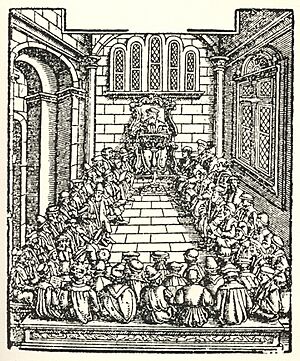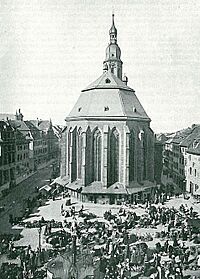History of Heidelberg University facts for kids

The history of Heidelberg University began when it was founded in 1386. It is one of the oldest universities in Germany.
Contents
Founding the University
Around the year 1400, the city of Heidelberg had about 3,000 people. At that time, a big split happened in the Christian church, called the Great Schism (1378). Two different popes were elected, one in Avignon and one in Rome. German leaders supported the pope in Rome. This meant German students and teachers in Paris had to leave.
Rupert I, a powerful ruler in the region, saw a chance to create something new. He asked Pope Urban VI for permission to start a university. On October 23, 1385, the Pope agreed. The final decision to open the university was made on June 26, 1386.
The new university was designed like the famous University of Paris. It had four main subjects:
- Philosophy (thinking about big ideas)
- Theology (studying religion)
- Jurisprudence (studying law)
- Medicine (studying health and healing)
On October 18, 1386, a special church service was held in the Heiliggeistkirche to celebrate the university's opening. The very first lesson was given on October 19, 1386. This makes Heidelberg the oldest university in Germany that has been open continuously.
In November 1386, Marsilius of Inghen became the first leader, called a rector. He chose a motto for the university's seal: semper apertus. This means "the book of learning is always open." The university grew quickly, and by March 1390, 185 students were studying there.
Early Years and Changes
From the very beginning, Heidelberg University was an important place for scholars. These were people who studied theology and law from all over the Holy Roman Empire.
Important thinkers like Rudolph Agricola and Johann Reuchlin taught here. They helped bring new ideas, known as humanism, to the university. Humanism focused on human values and achievements.
In 1518, a famous religious leader named Martin Luther visited Heidelberg. His ideas about changing the church had a big impact. Many students and teachers at Heidelberg became supporters of the Protestant Reformation.
Later, the ruler Otto Henry, Elector Palatine, changed the university to follow Calvinism, another branch of Protestantism. In 1563, the Heidelberg Catechism, an important religious text, was created with help from the university's divinity school.
Heidelberg University became a major center for learning. Scholars from across Europe came to study. However, when the Thirty Years' War began in 1618, the university faced hard times. In 1622, its famous library, the Bibliotheca Palatina, was taken to Rome. Later, in 1693, the city of Heidelberg was almost completely destroyed by King Louis XIV's troops.
After these difficult times, the university's Protestant focus changed. It was influenced by the Jesuits, a Catholic religious order. In 1735, the Old University building was constructed.
The university's reputation declined for a while. But then, the ruler Charles Theodore, Elector Palatine, helped it recover. He added new subjects and created scientific institutes. He also brought a school of political economy to Heidelberg. Despite these efforts, the university faced challenges due to the French Revolution. It lost much of its land and was almost closed down.
The 19th and Early 20th Centuries
The university's decline finally stopped in 1803. Karl Friedrich, Grand Duke of Baden, reopened it as a state-owned institution. From then on, the university was named after him and Ruprecht I. Karl Friedrich divided the university into five main faculties (departments).
During this time, a movement called Romanticism became popular in Heidelberg. It brought new life to German speech, poetry, and art. Students also formed groups that were very patriotic and later became involved in politics.
Heidelberg became a center for Liberalism, a movement that supported freedom and individual rights. Many professors at Heidelberg were important supporters of the Vormärz revolution. Some even joined the first freely elected German parliament in 1848.
In the late 1800s, the university was known for its open-minded spirit. Important thinkers like Max Weber and Ernst Troeltsch encouraged this. During the Weimar Republic (the German government after World War I), Heidelberg was seen as a place for democratic ideas. However, some dark forces were also present. A Nazi physicist named Philipp Lenard worked there. He caused trouble by refusing to lower the flag after a politician was killed, leading to protests.
The Nazi Era
When the Third Reich (Nazi Germany) came to power in 1933, Heidelberg University, like other German universities, supported the Nazis. Many staff and students were forced to leave because of their political views or their background. Many Jewish and Communist professors who did not leave Germany were sent away. At least two professors were killed by the Nazi regime.
On May 17, 1933, university faculty and students took part in book burnings in University Square. Heidelberg became known as a "Nazi university."
After World War II
After World War II ended, all universities in the American zone of Germany were closed. In April 1945, a group called the Counter Intelligence Corps (CIC) began looking into the university's Nazi activities. They also helped create a "Committee of Thirteen" professors to reopen the university. This group, which included anti-Nazi economist Alfred Weber and philosopher Karl Jaspers, wrote new rules for the university. These rules stated that the university must follow "The Living Spirit of Truth, Justice and Humanity."
In 1945 and 1946, the university went through a process called "denazification" to remove Nazi influences. Since Heidelberg was not destroyed during the war, the university was rebuilt fairly quickly.
Student groups called Studentenverbindung (dueling fraternities) were banned by the American authorities because of their role during the Nazi era. Professor Karl Heinrich Bauer, who became the first rector after the war, suggested creating a new type of college called the Collegium Academicum. This was inspired by colleges at Oxford and Cambridge in England.
During the 1960s and 1970s, the university grew a lot. It also became a major place for left-wing student protests in Germany. In 1975, police arrested the entire student parliament. Soon after, the Collegium Academicum building was raided by police and closed permanently. The Collegium was dissolved, and its buildings were turned into administration offices. A large new campus for medicine and natural sciences was built on the edge of the city.
Today, about 28,000 students study at Heidelberg University. There are over 4,000 full-time faculty members, including many professors. In 2007, the university was named a "University of Excellence." This is a special award from the German government to help a few top universities become even better and attract students from all over the world.
|



